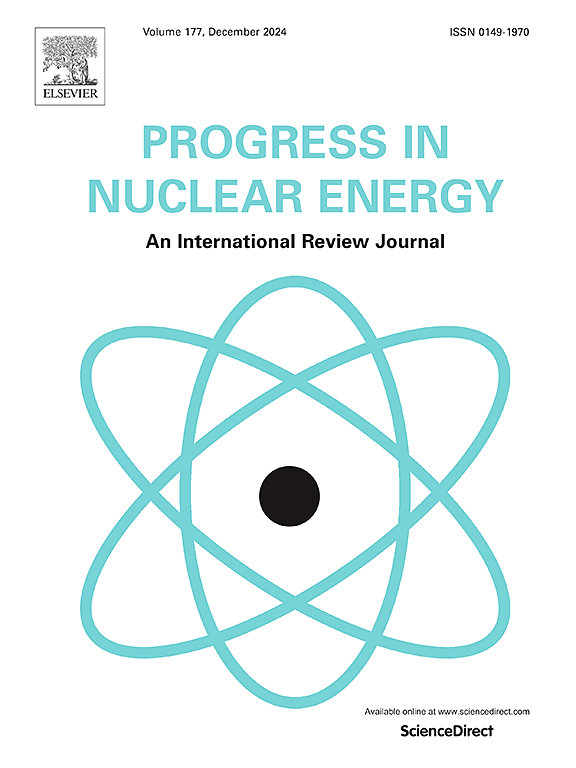Numerical study on influence of LFR water-cooled reactor vessel cooling system under unprotected loss of heat sink Accident
IF 3.2
3区 工程技术
Q1 NUCLEAR SCIENCE & TECHNOLOGY
引用次数: 0
Abstract
If both normal and emergency heat removal systems fail in a nuclear reactor after an accident occurs, safety and integrity will be severely threatened due to decay heat inside reactor. Passive external cooling outside the reactor vessel could be adopted for heat removal. And its specific design and influences are researched here. The Advanced Coupling code for Evaluating Fast spectrum Nuclear reactor Accidents(ACENA) developed by Xi'an Jiaotong University coupling point-kinetics model is used to simulate thermal hydraulics and neutronics phenomenon. STAR-LM is chosen as the research object for its integral air-cooled Reactor Vessel Cooling System(RVCS) design. Based on the schematic, water-cooled RVCS is modeled and analyzed. STAR-LM is modeled first in ACENA and parameters under steady state are compared with design values, validating the applicability and accuracy of related models. An Unprotected Loss of Heat Sink(ULOHS) accident is taken to analyze changing trends of temperatures inside the reactor which are references for following researches on RVCS. Influence factors including water mass flow rate and operating timing of RVCS are researched. According to simulation, a smaller mass flow rate of water injected causes worse cooling effects. But large and continuous water injection needs to avoid reactor power recovering. Additionally, delaying operation timing of RVCS could bring better cooling effects for nuclear reactor when satisfying safety limitation values. It provides a reliable tool for liquid metal fast reactor safety analysis. And certain experiences are obtained for RVCS design in lead-bismuth eutectic cooled fast reactors.
无保护散热器损失情况下LFR水冷堆容器冷却系统影响的数值研究
核反应堆发生事故后,如果正常排热系统和应急排热系统同时失效,反应堆内部的衰变热将严重威胁反应堆的安全性和完整性。反应堆容器外的被动外部冷却可以用来散热。并对其具体设计及影响进行了研究。采用西安交通大学开发的快谱核反应堆事故高级耦合程序(ACENA)耦合点动力学模型对热工水力学和中子现象进行模拟。选择STAR-LM作为研究对象,对其整体气冷反应堆容器冷却系统(RVCS)进行设计。在原理图的基础上,对水冷RVCS进行了建模和分析。首先在ACENA中对STAR-LM进行建模,并将稳态下的参数与设计值进行了比较,验证了相关模型的适用性和准确性。以一个无保护的热沉损失(ULOHS)事故为例,分析了反应堆内部温度的变化趋势,为后续的热沉损失研究提供参考。研究了水质量流量和RVCS运行时机等影响因素。模拟结果表明,注水质量流量越小,冷却效果越差。但是大量持续注水需要避免反应堆的电力回收。此外,在满足安全限值的情况下,延迟RVCS的运行时间可以为核反应堆带来更好的冷却效果。为液态金属快堆的安全性分析提供了可靠的工具。为铅铋共晶冷却快堆的RVCS设计提供了一定的经验。
本文章由计算机程序翻译,如有差异,请以英文原文为准。
求助全文
约1分钟内获得全文
求助全文
来源期刊

Progress in Nuclear Energy
工程技术-核科学技术
CiteScore
5.30
自引率
14.80%
发文量
331
审稿时长
3.5 months
期刊介绍:
Progress in Nuclear Energy is an international review journal covering all aspects of nuclear science and engineering. In keeping with the maturity of nuclear power, articles on safety, siting and environmental problems are encouraged, as are those associated with economics and fuel management. However, basic physics and engineering will remain an important aspect of the editorial policy. Articles published are either of a review nature or present new material in more depth. They are aimed at researchers and technically-oriented managers working in the nuclear energy field.
Please note the following:
1) PNE seeks high quality research papers which are medium to long in length. Short research papers should be submitted to the journal Annals in Nuclear Energy.
2) PNE reserves the right to reject papers which are based solely on routine application of computer codes used to produce reactor designs or explain existing reactor phenomena. Such papers, although worthy, are best left as laboratory reports whereas Progress in Nuclear Energy seeks papers of originality, which are archival in nature, in the fields of mathematical and experimental nuclear technology, including fission, fusion (blanket physics, radiation damage), safety, materials aspects, economics, etc.
3) Review papers, which may occasionally be invited, are particularly sought by the journal in these fields.
 求助内容:
求助内容: 应助结果提醒方式:
应助结果提醒方式:


